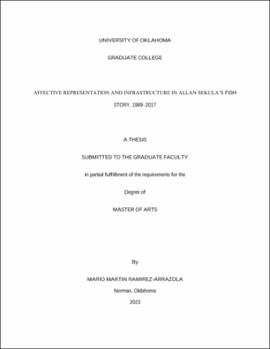| dc.contributor.advisor | Soppelsa, Peter | |
| dc.contributor.author | Ramirez-Arrazola, Mario | |
| dc.date.accessioned | 2023-05-03T18:05:17Z | |
| dc.date.available | 2023-05-03T18:05:17Z | |
| dc.date.issued | 2023-05-12 | |
| dc.identifier.uri | https://hdl.handle.net/11244/337520 | |
| dc.description.abstract | In 1989, contemporary American artist Allan Sekula (1951–2013) embarked on a seafaring project to document transnational seaports which would later be published as the iconic Fish Story (1989–1995). His personal notebooks during this voyage (among other several materials) would later be acquired by the Getty Research Institute in 2017 and turned into an archive. Fish Story would become perhaps Sekula’s most influential work. Sekula, a dedicated Marxist with highly influential commentary on globalization and capitalism (most of which arose through the medium of documentary photography and critical writing) directly confronted the mechanisms that allowed ports and sea-faring technologies to conduct profound capitalist processes, ultimately finding the entire system to be dangerously elusive. Sekula’s life and work is primarily handled within the fields of contemporary art history and criticism (with particular attention toward his sociocritical and historical work on photographic representation) but because of infrastructure studies’ continued integration of visual studies, he deserves more attention within the annals of the history of technology. Within scholarship on the history of technology we can find immediate relevance in his work that engaged with the themes of containerization and the methodological framework of infrastructural inversion. But, unlike what scholarship has settled for Sekula, it is the aim of this paper to cement his agency within infrastructure studies through an affectual approach. This will be done by surveying Sekula’s “sympathetic” documentary tendencies in relation to his experiences with infrastructural networks during the Fish Story voyage, the accounts of which are mainly mined from his personal notebooks. For clarity, the analysis splits up the survey of Sekula’s interaction with infrastructure into a pair: emotional and biographical narratives and representational and photographic theory and history. Near the end, the paper also incorporates recent scholarship Sekula’s archival practices and methods. Overall, this sort of techno-biographical survey of Sekula will showcase the tremendous relevance of a contemporary artist to the history of technology. | en_US |
| dc.language | en_US | en_US |
| dc.rights | Attribution-NonCommercial 4.0 International | * |
| dc.rights.uri | https://creativecommons.org/licenses/by-nc/4.0/ | * |
| dc.subject | infrastructure studies | en_US |
| dc.subject | contemporary art history | en_US |
| dc.subject | visual culture | en_US |
| dc.subject | American studies | en_US |
| dc.title | Affective Representation and Infrastructure in Allan Sekula's Fish Story, 1989-2017 | en_US |
| dc.contributor.committeeMember | Pandora, Katherine | |
| dc.contributor.committeeMember | Bailey, Robert | |
| dc.date.manuscript | 2023-05-02 | |
| dc.thesis.degree | Master of Arts | en_US |
| ou.group | Dodge Family College of Arts and Sciences::Department of History of Science | en_US |

